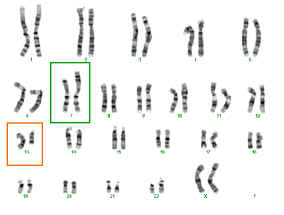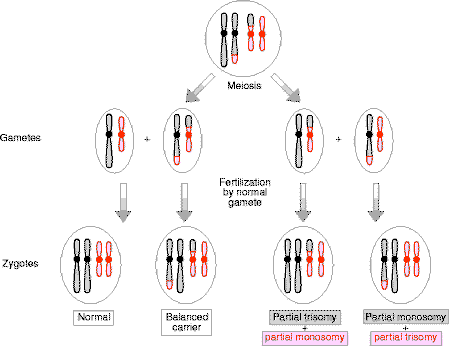|
There are two types of translocation: reciprocal and centric fusion (Robertsonian) |
|
Reciprocal translocation |
|
| A reciprocal translocation usually
involves breakage of two non-homologous chromosomes with exchange of the
fragments.
The total chromosome number remains at
46.
Incidence in the general population is about 1 in 500. |
 |
| The diagram below shows a break has occurred on the
short arm of one
chromosome number 7 and another on the long arm of one chromosome number
13. The parts of the chromosome arms distal to the breaks have exchanged places, resulting in a chromosome 7 missing part of its short arm but containing part of the long arm of chromosome 13. The chromosome 13 involved in the translocation has lost part of its long arm which now contains part of the short arm of chromosome 3.
|
|
 |
|
|
As there has been no gain nor loss of chromosomal material, this is a balanced rearrangement, and the person who has this pattern is normal and is a translocation carrier. All chromosomes can take part in reciprocal translocations, which are usually unique to a particular family.
|
|
| How the chromosomes segregate at meiosis in a balanced reciprocal translocation carrier | |
 |
A carrier of a balanced reciprocal translocation can produce unbalanced gametes, resulting in zygotes with partial trisomy and partial monosomy for the defined chromosomal regions. |
| Here 4 outcomes are shown:
(an animated
tutorial is also available to show the segregation)
A zygote with the pattern on the left has normal chromosomes. The second left zygote is a balanced reciprocal translocation carrier like the parent (and would be perfectly healthy - but could pass on the unbalanced form to his or her children). Zygotes with the two patterns on the right would have chromosomal imbalance, which may result in abortion, stillbirth, malformation and/or mental retardation. The relative frequency of each possible gamete is not readily predicted; the risk of having a child with each of the possible outcomes depends on its frequency in the gametes and on the likelihood of the conceptus with that abnormality developing to term. |
|
| PRACTICE POINT: karyotyping should be performed on couples who have had three or more pregnancy losses to detect translocation carriers | |